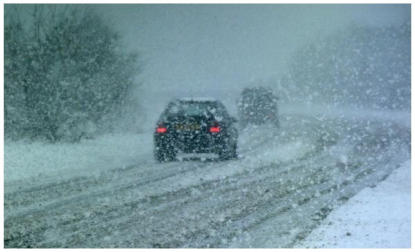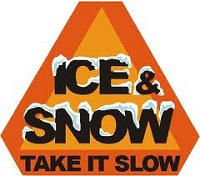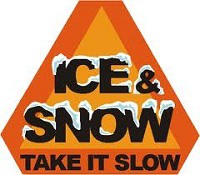
A to Z of Winter Driving



Anti freeze is your engine’s first line of defence against low temperatures. Each year check the concentration level and make
sure the system is free from leaks before winter arrives.
Batteries are subjected to severe stress in winter so make sure it is fully charged. Get the battery checked by a garage before
winter especially if you do a lot of short journeys (many garages will do this free of charge).
Corners shaded from the sun can be lethal in cold weather. When temperatures plunge - black ice can catch you out if you’re
not expecting it, a tell tale sign is the total absence of any noise from your tyres. If you suspect ice on the road slow down, steer
and brake gently and remember stopping distances can be up to TEN times that of normal.
De-icing may be a pain but it is very important that you make sure you have 100% all round visibility including your mirrors
before you drive away. If you leave your car outside overnight, cover the windscreen with a sheet or some cardboard. Make
sure your washer bottle is full of anti-freezing cleaning additive. If you have a garage - USE IT!
Electrics - make sure ALL your lights are clean and working and your demisters work efficiently. Check the windscreen wipers
and rubbers are working effectively.
Fog can suddenly appear and drift rapidly and is often patchy, drive slowly using dipped beam headlights. When visibility is
seriously reduced to below 100 metres also use front and rear fog lamps. Use your windscreen wipers and demisters to improve
visibility. Do not hang onto the tail lights of the vehicle in front as it can give you a false sense of security and means you may be
driving too close.
Grip is something you can’t have enough of in wintry conditions. Make sure all your tyres including the spare are correctly
inflated and have plenty of tread depth - do not be happy with the minimum tread depth of 1.6mm, your life could depend on that
couple of millimetres of tread that is missing? Remember that water is rubber’s natural lubricant and you will have less grip in
the wet.
Hail usually occurs unexpectedly and can be almost totally blinding for drivers, however it doesn’t usually last for long. Slow
down to a safe speed and use dipped beam headlights or stop if possible until it has blown over.
Ice is one of the most potentially dangerous driving conditions you will encounter. Keep a much greater distance from the
vehicle in front, up to ten times the distance as travelling on a dry road. Keep in the highest gear you can to avoid wheel-spin.
If you need to brake, get into a low gear early and use engine braking to slow you down then use the brake very gently.
If you do get into a skid, ease off what caused it (brake, steering, accelerator). Avoid braking on a bend or corner.
Journey - is it ABSOLUTELY NECESSARY? Have you checked the local weather forecasts and considered the advice given?
Have you told somebody of your estimated time of arrival at your proposed destination. Would taking a flask of hot drinks, food,
warm clothing (Blankets), Wellington’s, torch, jump leads, reflective jacket and shovel be a wise precaution? Ask yourself again
is your journey ESSENTIAL?
Keep in your vehicle until help arrives if you get into trouble. Abandoned vehicles cause problems for rescue vehicles and
snow ploughs. If you really have to leave your vehicle then make yourself visible by wearing a fluorescent jacket.
Leave your bed earlier and give yourself more time to deal with any delays.
Manual cars will move away more effectively on snowy surfaces if you use 2nd gear and accelerate gently. In automatics
select 2nd gear on snowy surfaces and stay in second as this will stop the car constantly changing up and down the gears.
Night journeys restrict your view and offer you less clues to any danger ahead. Heavy rain or snow will reduce the
effectiveness of your headlights. Be able to stop well within the distance illuminated by your headlights.
oversteer is when the vehicle steers MORE than you would expect and can lead to a loss of control on any surface but
especially in winter. This is where the back of the car tries to overtake the front and you will spin if you do not correct it
immediately. If the back of your car slides to the right then correct the slide by turning your wheel slightly in the same direction -
that is steer gently to the right. Do not over correct the steering as too much movement will cause a skid in the opposite
direction.
Ploughs and gritters do a vital job in appalling conditions. Give them plenty of room and stay well back. Do not overtake them
as you will then be travelling on untreated roads. They travel at a maximum of 40mph so be patient as they will probably leave
the road they are gritting soon.
Queues are more frequent during the winter months. Be patient and switch off your engine if you have a long wait - fears that
you engine won’t start again are generally unfounded.
Rear vision is extremely important. Do not move away until the rear demister has done it’s job, and make sure all mirrors are
clean and properly adjusted.
Sun can be very low in the sky in winter causing an underestimated hazard. Slow down and use you visor or better still a pair
of sunglasses which can easily be removed once the glare has gone.
Temperatures plummet in winter and zero degree Celsius (32 degrees Fahrenheit) is the freezing point of water. Be aware
that car outside temperature displays warn of ice at four degrees Celsius, this is because they measure air temperature and not
ground temperature which is usually four degrees lower.
Understeer is when the vehicle responds LESS than you would expect. Most front wheel drive cars understeer slightly. Load
and tyre pressures dramatically affect steering control.
Vehicle condition is very important - make sure your vehicle is properly maintained and service just before winter.
Winter tyres are worth considering as they improve safety by increased traction and reduced stopping distances whenever
the temperature drops below 7 degrees Celsius.
Xenon headlights offer advantages over halogen headlights. They provide a brighter light with less energy consumption and
last a lot longer.
You: are you ready for winter journeys? Have you had enough sleep, are you fit to drive, are you taking any medication that
could slow your reactions down and make you unsafe?
Zero tolerance to alcohol. Do not consume ANY alcohol within 24 hours of driving.
EVERY WINTER AN AVERAGE OF 6 DRIVERS ARE KILLED EVERY DAY
DON’T LET WINTER CATCH YOU OUT!
| Walmsley Driving School | www.wds1.karoo.net Hull| Driving Lessons | Hull | Learner | Advanced | Pass Plus | Diamond Advanced Instructor | Refresher Courses | Competitive Prices | Learn to drive
|Driving tuition| Chris Walmsley | IAM | DIA | RoSPA | Motorway Lessons | wds1.karoo.net | High quality tuition | Best | Premier | HU2 | HU3 | HU5 | HU7 | HU8 | HU9 | HU11 | HU12 | HU16 |







